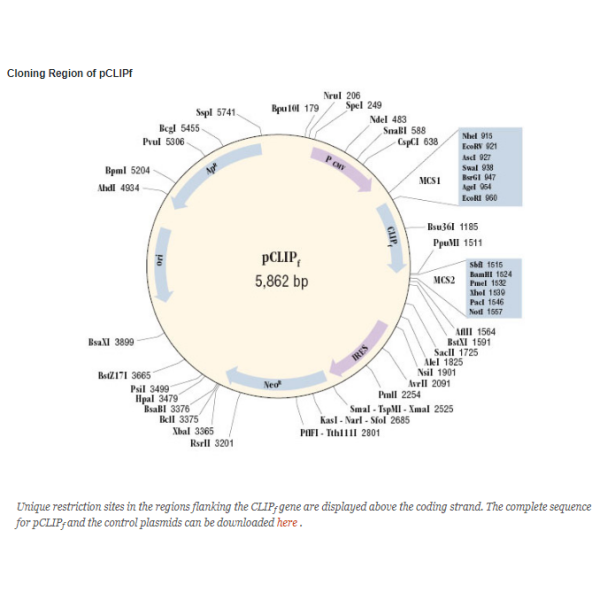N9215S, pCLIPf Vector - 20 µg
pCLIPf Vector is a mammalian expression plasmid intended for the cloning and stable or transient expression of CLIP-tag protein fusions in mammalian cells. This plasmid encodes CLIPf, a CLIP-tag protein, which is expressed under control of the CMV promoter. The expression vector has an IRES (internal ribosome entry site) and a neomycin resistance gene downstream of the CLIPf for the efficient selection of stable transfectants. pCLIPf Vector contains two multiple cloning sites to allow cloning of the fusion partner as a fusion to the N- or C-terminus of the CLIPf.
pCLIPf Vector is a mammalian expression plasmid intended for the cloning and stable or transient expression of CLIP-tag protein fusions in mammalian cells. This plasmid encodes CLIPf, a CLIP-tag protein, which is expressed under control of the CMV promoter. The expression vector has an IRES (internal ribosome entry site) and a neomycin resistance gene downstream of the CLIPf for the efficient selection of stable transfectants. pCLIPf Vector contains two multiple cloning sites to allow cloning of the fusion partner as a fusion to the N- or C-terminus of the CLIPf.
The CLIP-tag is a novel tool for protein research, allowing the specific, covalent attachment of virtually any molecule to a protein of interest. The CLIP-tag is a small protein based on human O6-alkylguanine-DNA-alkyltransferase (hAGT). CLIP-tag substrates are derivatives of benzylcytosine (BC). In the labeling reaction, the substituted benzyl group of the substrate is covalently attached to the reactive cysteine of CLIP-tag forming a stable thioether link.
pCLIPf contains an improved version of CLIP-tag, termed CLIPf. CLIPf displays faster kinetics in in vitro labeling and fast, specific and efficient labeling in live and fixed cell applications, thereby rendering it a desired research tool for analysis of protein dynamics.
Although CLIP-tag is based on the same protein as SNAP-tag®, the benzylcytosine substrates form a separate class of substrates, different from the benzylguanine substrates recognized by SNAP-tag. CLIP-tag and SNAP-tag can be used for orthogonal simultaneous labeling.
There are two steps to using this system: sub cloning and expression of the protein of interest as a CLIPf fusion, and labeling of the fusion with the CLIP-tag substrate of choice. Cloning and expression of CLIPf fusion proteins are described in this document. The labeling of the fusion proteins with CLIP-tag substrates is described in the instructions supplied with the CLIP-tag substrates.
| Price | 1.200,00 RON (preturile sunt fara TVA) |
|---|---|
| Description |
pCLIPf Vector is a mammalian expression plasmid intended for the cloning and stable or transient expression of CLIP-tag protein fusions in mammalian cells. This plasmid encodes CLIPf, a CLIP-tag protein, which is expressed under control of the CMV promoter. The expression vector has an IRES (internal ribosome entry site) and a neomycin resistance gene downstream of the CLIPf for the efficient selection of stable transfectants. pCLIPf Vector contains two multiple cloning sites to allow cloning of the fusion partner as a fusion to the N- or C-terminus of the CLIPf. There are two steps to using this system: sub cloning and expression of the protein of interest as a CLIPf fusion, and labeling of the fusion with the CLIP-tag substrate of choice. Cloning and expression of CLIPf fusion proteins are described in this document. The labeling of the fusion proteins with CLIP-tag substrates is described in the instructions supplied with the CLIP-tag substrates.
|

 English
English




